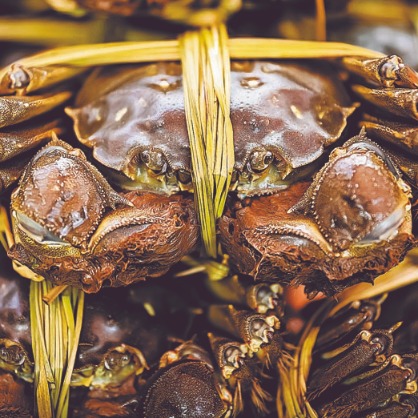



A new variety of crab is challenging the popular Yangcheng Lake version, Xing Yi reports in Shanghai.
When the summer heat fades and the chilly winds of a new season start to blow, hairy crabs, just like people, put on additional layers to deal with the dip in temperatures. Autumn thus marks the best time to savor this delicacy as the crabs are at their plumpest.
Of all the hairy crab breeding regions in China, Yangcheng Lake in Suzhou, Jiangsu province, has perennially been known to produce the best-tasting crustaceans because of the quality of its air, water and natural environment. Demand for Yangcheng Lake crabs has always been high. The same can be said for their prices.
Aware that demand far outstrips supply, some farmers go to the extent of having crabs raised in other places and then get them to spend a few days in the lake before harvest season commences so that the crustaceans can be passed off as Yangcheng Lake products.
But Shanghai's Chongming Island breeds crabs naturally and these crustaceans are making a name for themselves. It may offer stiff competition to the nearby incumbent in the years to come.

This year, the island is expected to harvest 450 metric tons of hairy crabs, up 12.5 percent compared to five years ago. The island is no stranger to this business, having started the breeding of hairy crabs in the 1980s. Back then, the locals only grew baby crabs that were sold to crab farmers who operated in bigger lakes across China. It was only after the turn of the millennium that the local government decided to shore up the island's production and sell mature crabs after identifying the growth potential of the industry.
Among those spearheading the development of the industry on the island is Chongming native Huang Chun, who was scouted by the island's officials in 2009 after he made a reputation for himself as an accomplished breeder in other parts of the country. Huang's first task was to raise the weight and quality of the crabs, which paled in comparison with those from Yangcheng Lake.
"The hairy crabs grown in Chongming used to be nicknamed wuxiaoxie, or "dark small crab", because most male crabs used to weigh less than 150 grams, while females were less than 100 grams," he says. "But I wanted to change that."
To achieve his goal, Huang worked closely with Wang Chenghui, a professor at Shanghai Ocean University, who had already developed a new breed of the hairy crab called Jianghai 21.

"We would select the best male and female crabs to breed, then choose the offspring that merited further breeding. After breeding several generations of crabs, we finally created a species that has a green shell, white belly, golden legs and yellow hair," says Wang, who has partnered with several crab farms, including Huang's Baodao Crab Farm, on Chongming Island, to perform large-scale experimentation.
In 2016, Wang's effort was recognized by the government as the Jianghai 21 variant gained approval of the then Ministry of Agriculture (now Ministry of Agriculture and Rural Affairs) for classification as a national "merit aquatic product breed".
"The new breed is bigger and grows faster, and following improvements in crab-farming, 70 percent of the female crabs now weigh more than 150 grams, while male crabs weigh more than 200 grams," Wang says.
Today, the price of a single hairy crab from Chongming Island ranges from 30 yuan ($4.5) to 200 yuan, a stark contrast to the past when it was sold for 10 or 20 yuan, says Huang.
The thriving industry has been a boon for Huang's business as well. His Baodao Crab Farm currently spans 46 hectares, up from the 26-hectare operation he started with, and generates about 75,000 kilograms of crabs every year.

In Chongming's Lyuhua township, 10 bed-and-breakfast guesthouses featuring crab-tasting sessions have opened this year. The town also held a crab-tasting festival on Nov 7 that featured eating competitions and activities such as catching crabs.
Yang Lihua, Party chief of the township, says crab-related tourism will continue and an aquaculture project-a 130-hectare crab pond powered by solar panels-will be launched.
But to Huang, who is currently the president of Shanghai River Crab Industry Association, it is a focus on quality and not quantity which will lead the industry to greater success.
"People started to ask me for hairy crabs during the National Day holiday in October, but I insisted on waiting till November to sell," he says.
"This year, autumn came later than usual, so we delayed the harvest of the crabs by around two weeks," he explains, adding that the best time to harvest the crabs would be when daytime temperatures were below 15 C.
While crabs from Yangcheng Lake still command the highest market share in Shanghai, those from Chongming are also becoming increasingly popular.

Gu Chao, a Shanghai chef and the culinary education director at Shanghai Industrial and Commercial Polytechnic, is among those who can attest to the quality of Chongming crabs.
"Chongming crabs used to be notoriously small. But this has changed. A friend recently opened a restaurant offering these crabs, and they are delicious," he says.
"Because the water in Chongming is slightly saltier compared to inland lakes, the flesh is more savory and therefore has more umami," he adds.
Huang has built a "crab museum" on his farm to highlight the tradition of indulging in this delicacy during autumn and winter months, and showcase the breeding process to visitors.
"When people understand the culture, they will eat the crab with more interest and find it tastier," Huang says. "I don't wish for people to pay a small fortune and not be able to appreciate what they are eating."
If you have any problems with this article, please contact us at app@chinadaily.com.cn and we'll immediately get back to you.